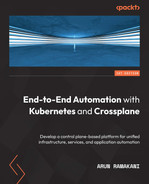Table of Contents
Preface
Part 1: The Kubernetes Disruption
Chapter 1: Introducing the New Operating Model
The Kubernetes journey
Characteristics of the new operating model
Team collaboration and workflows
Control theory
Interoperability
Extensibility
Architecture focus
Open source, community, and governance
The next Kubernetes use case
Summary
Chapter 2: Examining the State of Infrastructure Automation
The history of infrastructure automation
The need for the next evolution
The limitations of IaC
A Kubernetes operating model for automation
Multi-cloud automation requirements
Crossplane as a cloud control plane
A universal control plane
Open standards for infrastructure vendors
Wider participation
The cloud provider partnerships
Other similar projects
Summary
Part 2: Building a Modern Infrastructure Platform
Chapter 3: Automating Infrastructure with Crossplane
Understanding Custom Resource Definitions and custom controllers
Adding a new CRD
Working with the CRD
Understanding the Crossplane architecture
Managed resources
Providers
Composite resources
Crossplane core
Installing Crossplane
Installing and configuring providers
Setting up a cloud account
Installing a provider
Configuring the provider
Multiple provider configuration
An example of POSTGRES provisioning
Summary
Chapter 4: Composing Infrastructure with Crossplane
Feeling like an API developer
How do XRs work?
XRD
Composition
Claim
Postprovisioning of an XR
Readiness check
Patch status
Propagating credentials back
Preprovisioned resources
Building an XR
The infrastructure API requirement
Creating the XRD
Providing implementation
Provisioning the resources with a claim
Troubleshooting
Summary
Chapter 5: Exploring Infrastructure Platform Patterns
Evolving the APIs
API implementation change
Hands-on journey with composition revision
API contract changes
Non-breaking changes
Version upgrade
Version upgrade with breaking changes
Nested and multi-resource XRs
PatchSets
XRD detailed
Naming the versions
The openAPIV3Schema structure
The additional parameter of an attribute
Printer columns
Managing external software resources
Unifying the automation
Summary
Chapter 6: More Crossplane Patterns
AWS provider setup
Creating an AWS account and IAM user
Creating the Kubernetes secret
AWS provider and ProviderConfig setup
Managing dependencies
Resource reference within and nested XR
Referring to an outside resource
Secret propagation hands-on
Helm provider hands-on
Defining API boundaries
Alerts and monitoring
Enabling Prometheus to scrape metrics
Setting up monitoring alerts
Enabling the Grafana dashboard
More troubleshooting patterns
Summary
Chapter 7: Extending and Scaling Crossplane
Building a new provider
XRM detailed
Configuration fidelity
Spec and status configuration
Naming the custom and external resource
Configuration ownership
Sensitive input and output fields
Framework to build a provider
Packaging and distribution of XR/Claim
Packaging and distribution
Installing and using the configuration
Testing the configurations
Installing KUTTL
KUTTL test setup
TDD
Multi-tenant control plane patterns
Multi-tenancy with a single cluster
Multi-tenancy with multiple clusters
Summary
Part 3:Configuration Management Tools and Recipes
Chapter 8: Knowing the Trade-offs
Unified automation scope
Complexity clock, requirements, and patterns
The configuration complexity clock
Configuration management requirements
Patterns and trade-off
Open Application Model
KubeVela, the OAM implementation
Specialized and extendable abstraction
Specialized abstraction
Extendable abstraction
Impact of change frequency
XRM change frequency
Summary
Chapter 9: Using Helm, Kustomize, and KubeVela
Application configuration management capabilities
Using Helm for application deployment
Working with an existing chart
Hands-on chart development
Chart generation
Customizing configurations with Kustomize
Deploying application workloads with KubeVela
Anatomy of a KubeVela application definition
Summary
Chapter 10: Onboarding Applications with Crossplane
The automation requirements
The solution
Preparing the control plane
The GCP provider
The GitLab provider
Helm and Kubernetes provider setup
Automating the application deployment environment
The repository and CI setup
GitLab configuration
The onboarding XR/claim API
The deployment dependencies
API boundary analysis
Summary
Chapter 11: Driving the Platform Adoption
Why we need an infrastructure platform as a product
Understanding customers’ needs
Product development practices
Self-service
Collaborative backlog management
The platform product life cycle and team interaction
The OAM personas
Summary
Why subscribe?
Other Books You May Enjoy
..................Content has been hidden....................
You can't read the all page of ebook, please click here login for view all page.
